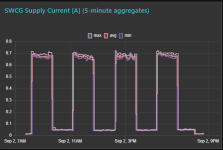Two years ago, I installed CircuPool RJ-60 SWCG in my pool. Now the third season is passing without any problems. It’s been a reliable and high-performance device. Last year I replaced my single speed Jandy pump with B&D 3HP VSP and added a Raspberry Pi pool controller of my own design running node-red.
The controller implements a basic functionality of scheduling the VSP, Polaris booster and SWCG, and ensuring that the booster and SWCG do not run if the VSP is not running. The controller also collects data from air and water thermistors and from transducers measuring AC current drawn by the VSP and SWCG.
Charts of the supply current to SWCG provide a visual assurance that the device is working as expected and its duty cycle is close to the power parameter set in the SWCG console.
The duty cycle interval is precisely 180 minutes except for those intervals where RJ-60 switches the current direction. It looks like in my 12 hours long day RJ-60 switches the current direction usually once.
Here is a chart of the SWCG supply current for Aug 29. The day starts at 8am and ends at 8pm. The setting of RJ-60’s power parameter (duty cycle) for that day is 60%. The RJ-60 follows this parameter very closely, except for one problem. In the fourth period we can see a short-lasting drop from 0.7A to the “rest” value of 50mA. This is where RJ-60 switched the current to the opposite direction and started a brand new “active” period, effectively increasing the average duty cycle for the day by several percentage points.

The chart below shows average duty cycles calculated for each of the last 7 days. The connecting red lines are not important here. The important elements are dots, which represent the average duty cycle value for each day, from 8am to 8pm in my schedule.

On Sep 2 at the beginning of the 8am-8pm day I modified the power parameter in RJ-60’s console from 60 to 50%. For that day the SWCG Supply Current looked like below, and you can see in the Daily Duty Cycle chart above a drop to 51%.

Below is SWCG Supply Current for Sep 3:

The controller implements a basic functionality of scheduling the VSP, Polaris booster and SWCG, and ensuring that the booster and SWCG do not run if the VSP is not running. The controller also collects data from air and water thermistors and from transducers measuring AC current drawn by the VSP and SWCG.
Charts of the supply current to SWCG provide a visual assurance that the device is working as expected and its duty cycle is close to the power parameter set in the SWCG console.
The duty cycle interval is precisely 180 minutes except for those intervals where RJ-60 switches the current direction. It looks like in my 12 hours long day RJ-60 switches the current direction usually once.
Here is a chart of the SWCG supply current for Aug 29. The day starts at 8am and ends at 8pm. The setting of RJ-60’s power parameter (duty cycle) for that day is 60%. The RJ-60 follows this parameter very closely, except for one problem. In the fourth period we can see a short-lasting drop from 0.7A to the “rest” value of 50mA. This is where RJ-60 switched the current to the opposite direction and started a brand new “active” period, effectively increasing the average duty cycle for the day by several percentage points.

The chart below shows average duty cycles calculated for each of the last 7 days. The connecting red lines are not important here. The important elements are dots, which represent the average duty cycle value for each day, from 8am to 8pm in my schedule.

On Sep 2 at the beginning of the 8am-8pm day I modified the power parameter in RJ-60’s console from 60 to 50%. For that day the SWCG Supply Current looked like below, and you can see in the Daily Duty Cycle chart above a drop to 51%.

Below is SWCG Supply Current for Sep 3:




